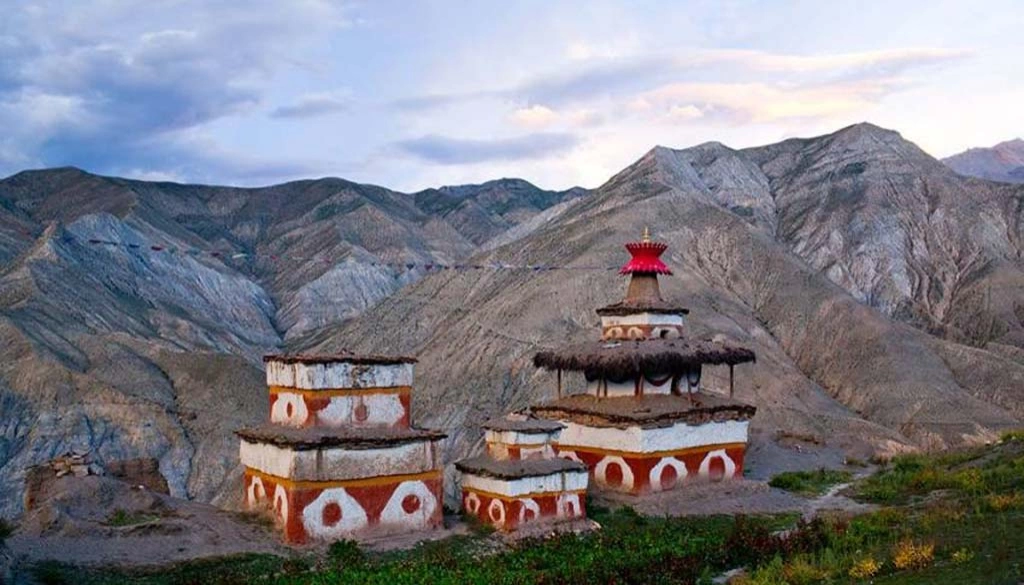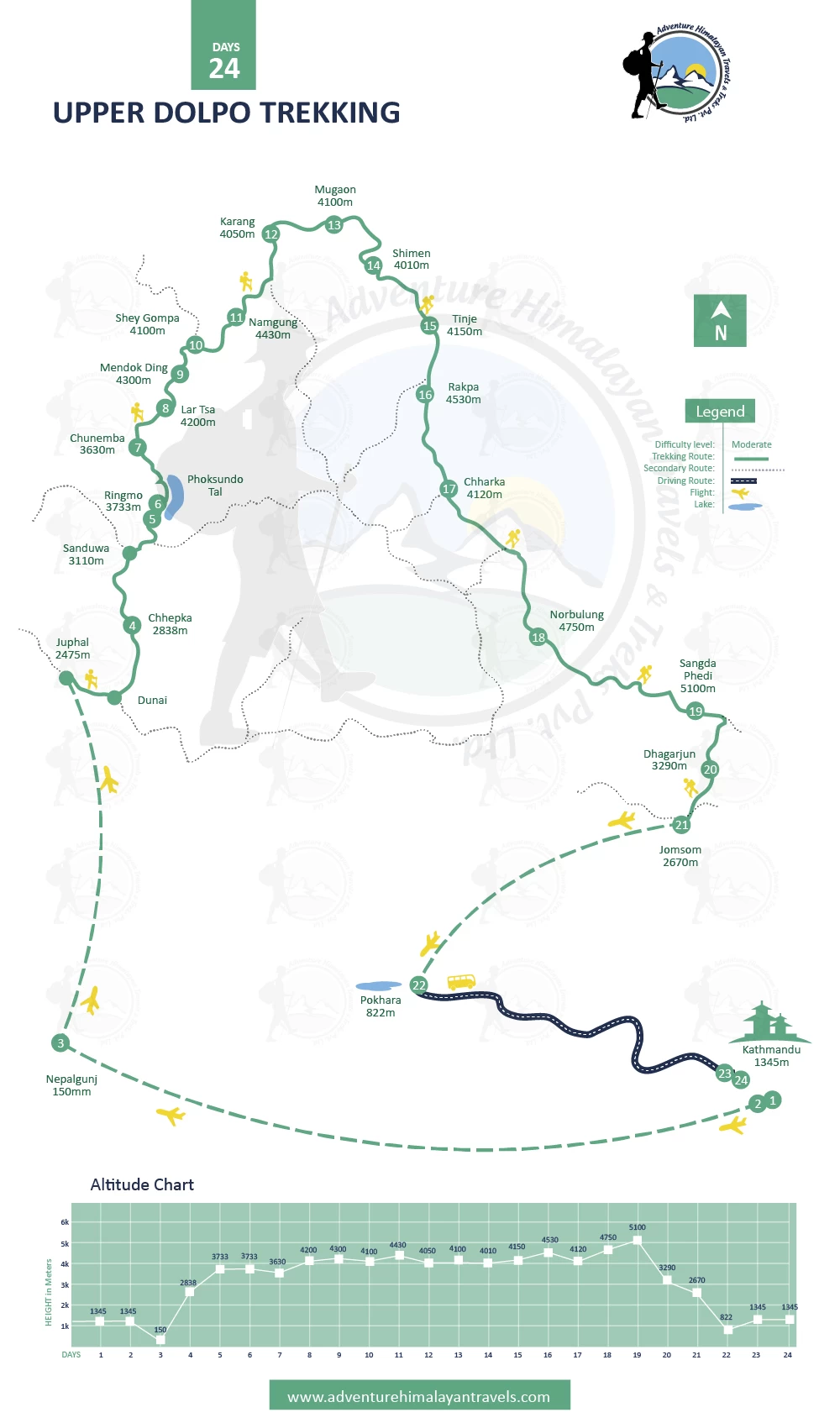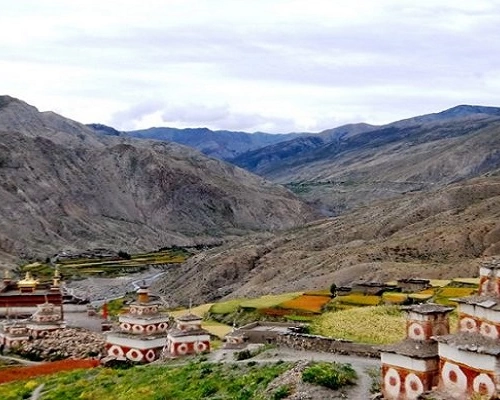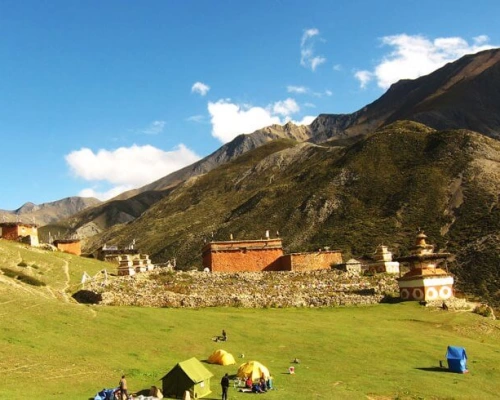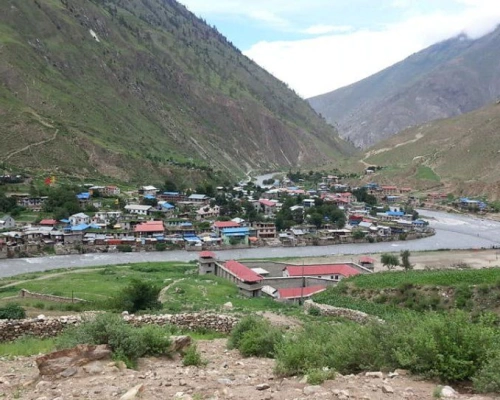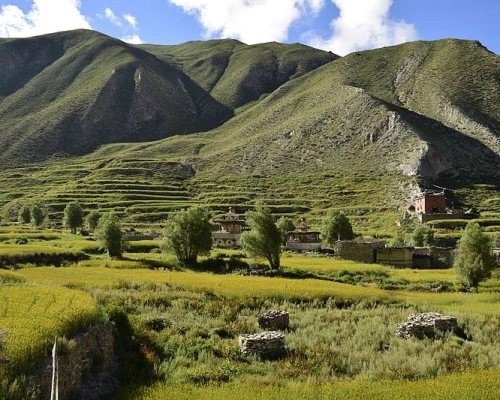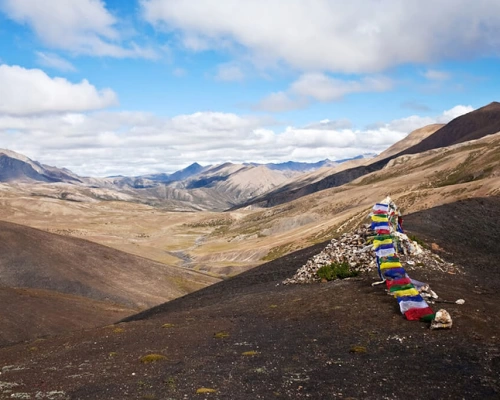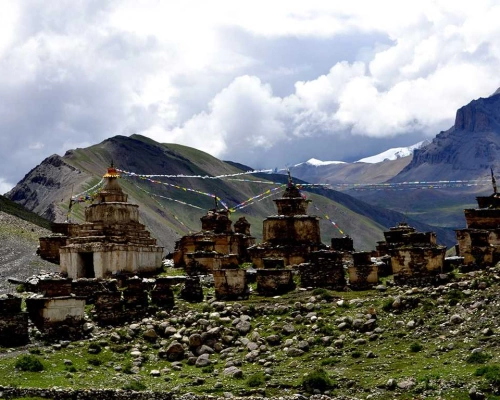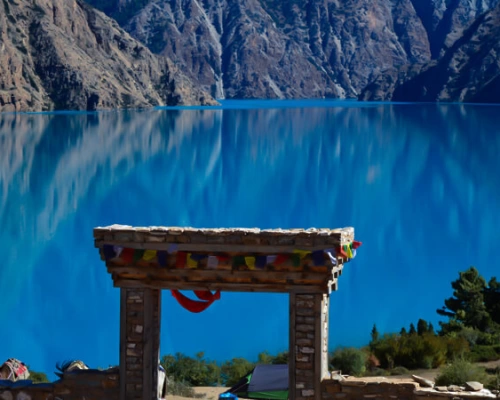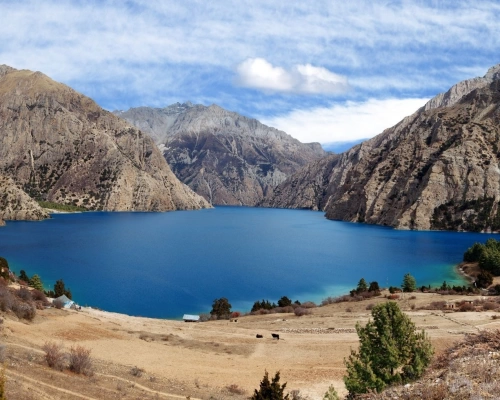Dolpa is located in the central-west area of the country. The main attraction of this area is the wild and pristine landscape, which is very different from all other parts of Nepal. Geographically it is part of the Tibetan Plateau and it is generally dry, cold and sparsely vegetated. The national park area and northern part is home of many rare and endangered animal species, including the snow leopard, musk deer and blue sheep.
The most obvious group of people seen in the northern parts of the area are of Tibetan origin. Similar to Tibetans and Sherpas they rely on making a living by subsisting on the high pastures and supplementing this with trade, both to the north and the south. For years, their salt caravans have been a common site along the mountain passes. Their religion is a mixture of Tibetan Buddhism and the ancient, pre-Buddhist Bon religion, a largely animistic faith. Their language is based on the Tibetan dialect spoken in Kham, a province of old Tibet.
Lower down the people are a mixture of ethnic groups, such as the Magar, Gurung and hill people of Hindu caste origin. Of particular interest are the Thakuri, the royal family caste. Again they are quite different in culture and language to their cousins further east. The area is generally very isolated and few tourists visit the area. Even few Nepalese from outside the area make a visit. For this reason, it's a privilege to be able to see this landscape and culture. There is nowhere else on Earth like the Upper Dolpo area. If you have the chance to visit, you must take it!
Upper Dolpo Trekking-24 Days
- Duration 24 Days
- Trip Grade Moderate
- Starts/Ends Kathmandu to Kathmandu
- Group Size 2-10
- Max. Altitude 5375 M.
- Best Season March, April, May and August, September, October
Itinerary
Upon your arrival at the Tribhuvan International Airport in Kathmandu, the Adventure Himalayan representatives will pick you up and transfer you to the hotel. After refreshment, you will be briefed in short about your tour by our guide or tour leader. If you have any questions or doubts about your trip then they should be asked and clarified at this time. Overnight stay at hotel.
Kathmandu Valley includes several UNESCO World Heritage Sites, including Pashupatinath (famous Hindu temple and cremation ground) Boudhanath (massive Buddhist stupa). We can also visit Swyambhunath, also known as Monkey Temple, which was built roughly 2000 years ago. Finally, we can visit Patan, city of fine arts. In the afternoon, you will be meeting with your trekking guide and will check all the necessary things. Overnight stay at the hotel.
To get to Dolpa, you have to fly to Nepalgunj first. Nepalgunj is a city in South Western Nepal, in the lowlands of Terai, close to the Indian border. You pass the busy of the bazaar and see horse carts full with people going to or coming from the Indian border. Overnight in hotel in Nepalgunj.
In the morning, we take a spectacular 35 minute flight over steep mountain ridges to Juphal. Juphal airport is just a gravel airstrip amidst the mountains and Juphal a small, mostly Hindu village. From Juphal you walk down over a small path among fields with wheat and vegetables to the Thuli Bheri River. Soon, we see a big iron suspension bridge, the Dhim Bridge of 99 m long. This is the entrance to the Shey Phoksundo National Park (SPNP). SPNP is Nepal’s largest National Park, established in 1984, with an area of 3,555 km⊃2. It aims to conserve the Trans-Himalayan ecosystem and the Tibetan type of flora and fauna. In 1998, and area of 1,349 km2. You have to pay 1000 rps entrance fee (except persons from SAARC countries, who pay 100 rps). We walk along the quiet path for several hours through forests and along emerald green rivers. More or less an hour after Shyanta, you reach Chhepka, a small village, surrounded by fields of barley. Overnight in Chhepka.
It’s a short hike today to Ringmo and the Phoksundo Lake. After about an hour or two of trekking, we reach a viewpoint, where we will see a Nepal's highest waterfall of 167 meters high, the Suligad Waterfall (also called Phoksundo Waterfall). A nice place for a little break. 5 minutes after the viewpoint you will reach the top, and you will have your first view of the view of the Phoksundo Lake. It’s now half an hour more Nepali flat, walking through the forests, till you reach Ringmo. Overnight in Ringmo.
As the Phoksundo Lake is such a beautiful place, a free day here is recommended. Ringmo is a charming village that lies on the shore of Phoksundo Lake. People practice the Bonpo religion here. At the other shore, there is a beautiful Bonpo Monastery which you can visit. It’s a 20 minute walk to the monastery through the pine forest. In the monastery you can observe a statue of Thönpa Chenrab, the founder of Bonpo religion, a Buddha who lived thousands of years ago.
The trail contours along a rocky ledge. Climb to a crest at 4060m for spectacular views of Sonam Kang. The trail make steep and dusty descent through birches and blue pines.
After a nice break, we resume our journey towards Chunemba. The trekking route is about 5 hours long in total. We can enjoy the beautiful scenic beauty throughout the way while passing through the trail. Overnight in Chunemba.
The route follows the valley of Kang Gompa. We climb steeply and stay on grassy ridge, passing a few groves of birch trees. There are spectacular views of Shey Shikar (6239m) and Kang Chunne (6443m). After crossing 4200m the route descends gently on a rocky trail to Lar Tsa. Overnight in Lar Tsa.
After taking breakfast at the lodge, we cross a bridge and climb to the top of slope at 4500m. After enjoying the amazing views, we descend gently to Mendok Ding. We are surrounded by a barren, yet amazingly beautiful landscape. Overnight in Mendok Ding.
After breakfast, we head on our way. We cross the Dolma La and descend the steep narrow trail to Shey Gompa. Trail crosses slopes to grassy meadows and passes the old Tsakang Gompa. The trail is out of this world. Rolling orange-brown hills with snowcapped peaks surround us. Overnight in Shey Gompa.
After our breakfast, we head for the Shey La Pass (5010m). We feel like we are on top of the world. After snapping some photos, we descend before climbing again to Namgung. Overnight in Namgung.
Trail ascent and descends along the Namgung Khola to Karang. Passing smiling faces through the high alpine landscape, every moment we are entertained along the way. Our journey today takes about 5-6 hours. Overnight in Karang.
We begin our journey after taking breakfast. First, the trail descends to Torak Sumdo before climbing up to Yanger Gompa at 3750m. We continue, trekking along the river to the side valley. If we're lucky, we might see a yak caravan along the way. We ascend a bit more and arrive at Mugaon. Overnight here.
Beginning our journey after breakfast, the trail descends to the valley of Mugoan. We climb towards to Mushi La (5030m). The views from here are spectacular. From the pass, the trail descends to Shimen village. Overnight at Shimen.
Our journey today is absolutely stunning. We are constantly exposed to mountain views, feeling the sensation that we are truly in the middle of nowhere. We make the long trek through river to Pha (4090m). We can take a rest here before continuing on to reach Tinje. Overnight here.
After breakfast, we make our way to Rakpa. The path follows the bank of a river and ascend to a trail junction at (4130m), where a high route leads to Tarap. We continue southward to a campsite on the banks of the river at Rakpa (4530m). Overnight in Rakpa.
We begin our day with a long climb to the Chharka-La (4920m). We continue on the trail descending along the side of the valley, then descent into a valley (4290m). We then make a long traverse down to the picturesque village of Chharka on the banks of Barbung Kola at (4120m). Chharka is a small hamlet of closely-built, white-washed dwellings, medieval in feel, with a Bonpo monastery, Sarchhen Gompa. Overnight in Chharka.
We follow the Chharka Khola to the intersection of the Thansan Khola, having to cross the river on a small bridge. The campsite right after this river crossing is Sumdo, and we may set up camp for the night here, or we may continue on to a campsite called Norbulung, down the east bank of the Thansan Khola. Overnight in Norbulung.
We begin the day by climbing to a yak pasture at Molum Sumna (4860m) and on to a crest at 5130m. We then make a long traverse across meadows to the base of the Sangda-La, then a long, steep final climb to the pass at 5460m. Switchbacks descend down to our camp site by a stream at 5100m. Overnight in Sangda Phedi.
After having breakfast, we head to Dhagarjun. The trail ascends and descends a number of times, crossing a total of nine ridges, before finally descending to the Kaligandaki Valley, reaching the village of Dhagarjun. Overnight here.
Today, we trek directly south towards Jomsom, the district headquarters of Mustang, back to 'Civilization' on the Annapurna Circuit. We reach the long, cobbled path that connects upper and lower Jomsom. We relax in Jomsom and celebrate the near-end of our trek. Overnight in Jomsom.
We take the scenic morning flight from Jomsom to Pokhara which takes about 35 minutes. During the flights in morning, the sky looks very clear which makes you able to enjoy the splendid views of different mountain peaks. You can take the rest of the day to explore Pokhara. Overnight at hotel on BB basis.
Or if you would like to choose by bus, we will arrange ticket in tourist coach at river side seat and start your journey at 7:30 am from Pokhara. Left site's seats of vehicles are nice to enjoy the scenery; the road follows by Trisuli River where you see many people rafting on the river. After 6/7 hours you will arrive at Kathmandu, and we'll transfer to your hotel. You can spend the rest of the day how you'd like, but we have a celebratory Nepali dinner for you in the evening! Overnight at hotel on BB basis.
We will transport you to the airport. Thanks for trekking with Adventure Himalayan travels. We look forward to seeing you again!
This itinerary is not suited for you? Plan your own trip.
What's Included
- 18 nights and 19 days of food and accommodation during trek (tent)
- Kathmandu - Nepalgunj - Juphal and Jomsom - Pokhara airfare, Pokhara to Kathmandu bus ticket
- English speaking local expert guide( porters,cook,sherpa and helper)
- Upper Dolpa permit fees ($500 for 10 days, $50/day after 10 days)
- Annapurna Conservation Area Permit (ACAP)
- Trekkers’ Information Management System (TIMS) fees
- Three nights’ accommodation at three star hotel in Kathmandu on twin sharing with breakfast, one night in Pokhara with bed and breakfast, and one night in Nepalgunj with bed and breakfast
- Airport transfers and escort
- Farewell dinner in Kathmandu
- Equipment clothing for porter & staffs
- Equipment (sleeping bag, first aid kit, oximeter etc.)
- tent,sleeping bag,kitchen equipment,jacket etc.
- Insurance for all staff & porters.
- Trekking achievement certificate
- Adventure Himalayan Tshirt
- Nepal visa - Multiple Entrée 30 days - USD 50 (Details in Visa Page)
- International flight
- Lunch & dinner during hotel stay in Kathmandu
- Hot shower and electronic charging fees at guest houses during the trek
- Alcoholic drinks, candies, etc.
- Extra accomodation and meals outside of itinerary
- Personal gears & clothing (available on hire)
- Tips, any expenses incurred in emergency evacuation/road block due to any reason, table drinks, snacks while walking.
Dates and Prices
| Date | Price | Availability | ||
|---|---|---|---|---|
| Start DateStarts: ThursdayApr 17, 2025 | End DateEnds: SaturdayMay 10, 2025 | PricePriceUS$3575 | StatusStatusAvailable | |
| Start DateStarts: MondayApr 21, 2025 | End DateEnds: WednesdayMay 14, 2025 | PricePriceUS$3575 | StatusStatusAvailable | |
| Start DateStarts: ThursdayApr 24, 2025 | End DateEnds: SaturdayMay 17, 2025 | PricePriceUS$3575 | StatusStatusAvailable | |
| Start DateStarts: MondayApr 28, 2025 | End DateEnds: WednesdayMay 21, 2025 | PricePriceUS$3575 | StatusStatusAvailable |
